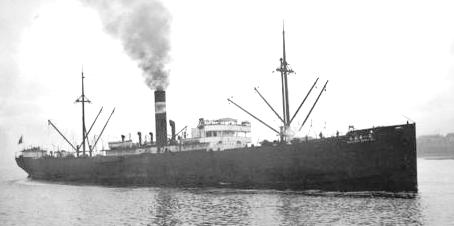RIKUGUN YUSOSEN
 (Sister SHINSEI MARU No. 1, prewar)
(Sister SHINSEI MARU No. 1, prewar)
TOYOHASHI MARU:
Tabular Record of Movement
© 2016 Bob Hackett
1914:
Kobe. Laid down at Kawasaki Dockyard Co. Ltd. as a 7,029-ton passenger/cargo ship.
E 1914:
Launched and named TOYOHASHI MARU
March 1915:
Completed for Nippon Yusen Kaisha (NYK Line), K. K.
18 November 1941:
Requisitioned by the Imperial Army (IJA) and converted to a troop transport. Allotted IJA ship No. 420,
17 December 1941: Operation "M" (M Sakusen) -The Invasion of Lamon Bay, S Luzon, Philippines:
Imperial General Headquarters launches the combined IJA and IJN Lamon Bay Operation. The Army force consists of Gen (later Field Marshal) Count Terauchi Hisachi’s Southern Expeditionary Army. Its 14th Army, under LtGen Homma Masaharu, fields MajGen Morioka Susumu's Invasion Unit of about 7,000 troops consisting of elements of the 16th Infantry division: 20th Infantry, 22nd Field Artillery, HQ and II Battalion, 16 HQ Coy, 16th Eng Battalion, 16th Recon Battalion, 3/45 AA Coy, 16th Transport, 16th Signal Coy, 16th Med Unit and 16th Vet Unit. Two AA and one Signals Regiment are stationed on IJA transports (Yusosen).
The invasion units are embarked on 20 IJA transports: TOYOHASHI, BENGAL, DAINICHI, DURBAN, KAIMEI, KAYO, KITANO, KOFUKU, LISBON, NAGATO, NICHIREN, RYOKA, RYUYO, SHINSEI, SHINSHU (4182 GRT), TAIAN, TATSUNO, TOFUKU and TOYAMA MARUs and TAMON MARU No. 5.
The naval force consists of Vice Admiral (later Admiral) Kondo Nobutake's (35)(former CO of KONGO) Southern Force, Philippines Invasion Group that includes Vice Admiral Takahashi Ibo’s (35)(former CO of YAMASHIRO) Third Fleet. Rear Admiral (later Vice Admiral) Kubo Kyuji’s (38) (former CO of KAGA) Invasion Unit consists of his 1st Base Force HQ, in light cruiser NAGARA, 1st Naval Guard Unit aboard KIMISHIMA MARU, 1st Quartermaster Ports and Docks Unit and 1st Naval Signal Unit, aboard HAKUSAN MARU, 1st Naval Survey Unit in SENKO MARU and Captain (later Vice Admiral) Mori Kunizo's (40)(former CO of SATA) Sasebo No. 1 and 2 Combined Special Naval Landing Force (SNLF) aboard MYOKO MARU.
The convoy’s escort consists of light cruiser NAGARA (F), heavy cruiser ASHIGARA, destroyers TOKITSUKAZE, YUKIKAZE, KAWAKAZE, UMIKAZE, YAMAKAZE, minelayer AOTAKA, minesweepers W-7 and W-8, auxiliary gunboat/minelayer IKUSHIMA MARU, auxiliary gunboats BUSHO, KEIKO, KANKO and MYOKEN MARUs, auxiliary subchasers SHONAN MARU No. 17 and TAKUNAN MARU No. 5 and auxiliary netlayer FUKUEI MARU No. 15.
The Invasion Force departs Koniya, Amami Oshima for Lamon Bay, Quezon, Philippines.
24 December 1941:
The Invasion Force arrives at Lamon Bay and the landings proceed without strong opposition.
14 May 1942:
Singapore harbor. Three thousand Australian prisoners-of-war (POWs) are marched from Changi jail for transport to Burma. About 2,000 POWs are embarked on TOYOHASHI MARU. The remaining 1,000 POWs are embarked aboard CELEBES MARU. [1]
15 May 1942:
At 0100, the last of the POWs is embarked. TOYOHASHI and CELEBES MARU then steam from Singapore to Belawan and Medan, N Sumatra.
16 May 1942:
Sumatra. 350 IJA troops are embarked aboard CELEBES MARU.
17 May 1942:
Departs Medan for Victoria Point, Burma (now Myanmar) in a convoy now joined by ENGLAND and KYOKUSEI MARUs and an unidentified minesweeper. ENGLAND and KYOKUSEI MARUs are carrying British and Dutch POWs. [1]
20 May 1942:
The convoy arrives at Victoria Point. One Australian battalion of 1,017 POWs is disembarked from TOYOHASHI MARU and the Dutch POWs are disembarked from KYOKUSEI MARU.
24 May 1942:
Arrives at Mergui, Burma. Another battalion of about 1,000 POWs is disembarked.
27 May 1942:
Arrives at Sinbyubyin, the quarantine port for Tavoy, Burma. The remaining battalion of 983 men is disembarked. Despite heat, disease, and deprivations aboard CELEBES MARU, all the POWs survive the voyage. They are put to work repairing and constructing an airfield, and later, building the Burma-Siam (Thailand) railway. Many die.
1 June 1942:
At 0925, CELEBES MARU departs Sinbyubyin, Burma for Singapore in an unescorted convoy consisting of TOYOHASHI, ENGLAND and KYOKUSEI MARUs.
4 June 1942:
Malacca Strait. SW of Phuket, Malaya. At 0335, British LtCdr Edward F. Balston’s submarine HMS TRUSTY torpedoes TOYOHASHI MARU at 07-14N, 98-06E. At 0400 , she sinks. One crewman and 16 gunners are KIA. The survivors are rescued by KYOKUSEI MARU.
Authors' Note:
[1] TOYOHASHI. CELEBES, ENGLAND, HIOKI, KYOKUSEI, MIYO and TAMAHOKO MARUs were considered "Hell Ships" by Allied POWs.
Thanks go to Erich Muehlthaler of Germany
Bob Hackett
Back
to IJA Transports





